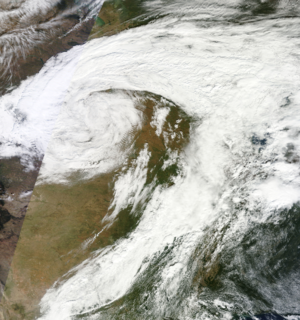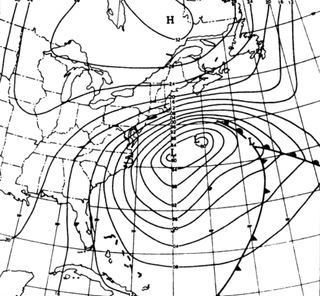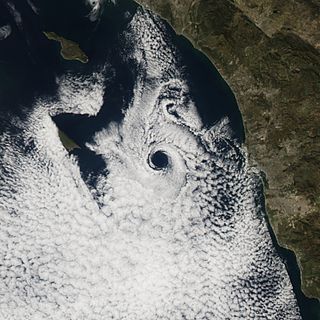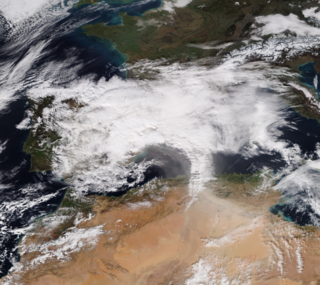 W
WThe 1996 Lake Huron Cyclone, commonly referred to as Hurricane Huron, Cyclone Huron, or the Lake Huron Subtropical Cyclone of 1996, was an extremely rare, strong cyclonic storm system that developed over Lake Huron in September 1996. The system resembled a subtropical cyclone at its peak, having some characteristics of a tropical cyclone. It was the first time such a storm has ever been recorded over the Great Lakes region.
 W
WA massive blizzard and tornado outbreak that affected the Northwest, Rockies, and much of the Midwest in early-October 2013. A total of 22 tornadoes were confirmed as the system moved eastward across the eastern half of the United States, including two that were rated EF4.
 W
WThe Ash Wednesday Storm of 1962 occurred on March 5–9, 1962 along the mid-Atlantic coast of the United States. Also known as the Great March Storm of 1962, it was considered by the U.S. Geological Survey to be one of the most destructive storms ever to affect the mid-Atlantic states. Classified as a level 5 or Extreme Nor'easter by the Dolan-Davis scale for classification of Atlantic Nor'easters it was one of the ten worst storms in the United States in the 20th century. It lingered through five high tides over a three-day period, killing 40 people, injuring over 1,000, and causing hundreds of millions in property damage in six states. The storm also deposited significant snowfall over the Southeast, with a regional snowfall index of 12.663.
 W
WThe "Catalina eddy" wind pattern, also called the "coastal eddy," is a localized weather phenomenon that occurs in the "Bight of California", the mostly concave portion of the Southern California coast running from Point Conception to San Diego. The Catalina eddy leads to "June Gloom" which is so much a part of the late spring and early summer weather in Southern California. The eddy gets its name from Santa Catalina Island, the Channel Island closest to the Los Angeles-Long Beach area; the center of an eddy is often located above or near the island.
 W
WDiablo wind is a name that has been occasionally used for the hot, dry wind from the northeast that typically occurs in the San Francisco Bay Area of Northern California, during the spring and fall. The same wind pattern also affects other parts of California's coastal ranges and the western slopes of Sierra Nevada, with many media and government groups using the term Diablo winds for strong, dry downslope wind over northern and central California. The term first appeared shortly after the 1991 Oakland firestorm, perhaps to distinguish it from the comparable, and more familiar, hot dry wind in Southern California known as the Santa Ana winds. In fact, in decades previous to the 1991 fire, the term "Santa Ana" was occasionally used as well for the Bay Area dry northeasterly wind, such as the one that was associated with the 1923 Berkeley Fire.
 W
WStorm Gloria was a Mediterranean storm which affected eastern Spain and southernmost France with high winds and heavy rainfall. The system was named Gloria by the Spanish meteorological agency AEMET on 18 January, becoming the tenth named storm of the 2019–20 European windstorm season. The Free University of Berlin named the system Ilka.
 W
WThe Groundhog Day gale was a severe winter storm that hit the northeastern United States and southeastern Canada on February 2, 1976.
 W
WHog Island was the name of two islands near Long Island, New York until the 1890s. One is the present day Barnum Island, which includes the villages of Island Park and Harbor Isle in Nassau County. The other was a mile-long (1600 m) barrier island that existed to the south of Rockaway Beach in Queens before being mostly destroyed by the 1893 New York hurricane and completely lost to erosion and storm damage by 1902.
 W
WJune Gloom is a California term for a weather pattern that results in cloudy, overcast skies with cool temperatures during the late spring and early summer. While it is most common in the month of June, it can occur in surrounding months, giving rise to other colloquialisms, such as "May Gray", "No-Sky July", and, rarely, "Fogust". Low-altitude stratus clouds form over the cool water of the California Current, and spread overnight into the coastal regions of Southern California. The overcast skies often are accompanied by fog and drizzle, though usually not rain. June Gloom usually clears up between mid-morning and early afternoon, depending on the strength of the marine layer, and gives way to sunny skies. On a strong June Gloom day, the clouds and fog may extend inland to the valleys and Inland Empire and may persist into the mid-afternoon or evening.
 W
WThe Regional Snowfall Index (RSI) is a system used by NOAA to assess the societal impact of winter storms in the United States. The system is a replacement for the Northeast Snowfall Impact Scale (NESIS) system which, unlike the former; assesses winter storm impacts outside of the Northeastern United States. Since its initiation the NCDC has retroactively assigned RSI values to over 500 historical storms since 1900.
 W
WA nor'easter is a macro-scale extratropical cyclone in the western North Atlantic Ocean. The name derives from the direction of the winds that blow from the northeast. The original use of the term in North America is associated with storms that impact the upper north Atlantic coast of the United States and the Atlantic Provinces of Canada.
 W
WThe North American monsoon, variously known as the Southwest monsoon, the Mexican monsoon, the New Mexican monsoon, or the Arizona monsoon, is a pattern of pronounced increase in thunderstorms and rainfall over large areas of the southwestern United States and northwestern Mexico, typically occurring between July and mid-September. During the monsoon, thunderstorms are fueled by daytime heating and build up during the late afternoon-early evening. Typically, these storms dissipate by late night, and the next day starts out fair, with the cycle repeating daily. The monsoon typically loses its energy by mid-September when much drier conditions are reestablished over the region. Geographically, the North American monsoon precipitation region is centered over the Sierra Madre Occidental in the Mexican states of Sinaloa, Durango, Sonora and Chihuahua.
 W
WPacific Northwest windstorms, sometimes colloquially known as Big Blows, are extratropical cyclones which form in the Pacific basin, and affect land areas in the Pacific Northwest of the United States and British Columbia, Canada. They form as cyclonic windstorms associated with areas of low atmospheric pressure that track across the North Pacific Ocean towards western North America. Deep low pressure areas are relatively common over the North Pacific. They are most common in the winter months. On average, the month when most windstorms form is November or December.
 W
WThe Portland Gale was a storm that struck the coast of New England on November 26 and 27, 1898. The storm formed when two low pressure areas merged off the coast of Virginia and travelled up the coast; at its peak, it produced a storm surge of about ten feet in Cohasset harbor and hurricane-force winds in Nantucket. The storm killed more than 400 people and sank more than 150 boats and ships. It also changed the course of the North River, separating the Humarock portion of Scituate, Massachusetts, from the rest of Scituate.
 W
WThe October 2015 North American storm complex was an extratropical storm that triggered a high precipitation event, which caused historic flash flooding across North and South Carolina. The incipient cold front traversed the Eastern United States on September 29–30, producing heavy rain in multiple states. The system subsequently stalled just offshore. Tapping into moisture from the nearby Hurricane Joaquin, a developing surface low brought heavy, continuous rain to southeastern States, with the worst effects concentrated in South Carolina where catastrophic flooding occurred. The event culminated in South Carolina on October 4 when numerous rivers burst their banks, washing away roads, bridges, vehicles, and homes. Hundreds of people required rescue and the state's emergency management department urged everyone in the state not to travel. Some areas of the state saw rainfall equivalent to a 1-in-1000-year event.
 W
WThe tornado outbreak and floods of April 28 – May 1, 2017 were a series of severe weather events that affected the central United States, producing life-threatening flooding and a major tornado outbreak. It formed out of a disturbance in the Southwestern United States on April 28, and caused significant impacts, including a heavy snowstorm in the Rockies, and other types of severe weather. Up to 3 feet (36 in) of snow fell on the cold side of the system, and up to a foot of rain fell in and around the central parts of the nation.
 W
WTule fog is a thick ground fog that settles in the San Joaquin Valley and Sacramento Valley areas of California's Central Valley. Tule fog forms from late fall through early spring after the first significant rainfall. The official time frame for tule fog to form is from November 1 to March 31. This phenomenon is named after the tule grass wetlands (tulares) of the Central Valley. Tule fog is the leading cause of weather-related accidents in California.
 W
WWellington was a small unincorporated community and railroad community in the northwest United States, on the Great Northern Railway in northeastern King County, Washington.
 W
WWinter storm naming in the United States has been used sporadically since the mid-1700s in various ways to describe historical winter storms. These names have been coined using schemes such as the days of the year that the storm impacted or noteworthy structures that the storm had damaged and/or destroyed. In the 2010s, winter storm naming became controversial with The Weather Channel coming up with its own list of names for winter storms similar to that of hurricanes. Various other media outlets soon followed suit with their own naming lists. Meteorologists argue that winter storms can reform more than once, making the process of naming them both difficult and redundant. Those in favor of naming winter storms argue that the names help people with preparation. Entities from the United States government, including the National Oceanic and Atmospheric Administration (NOAA) and the National Weather Service (NWS), have stated that they would not be naming winter storms, and have asked others to refrain from doing so.
 W
WThe year 1816 is known as the Year Without a Summer because of severe climate abnormalities that caused average global temperatures to decrease by 0.4–0.7 °C (0.7–1 °F). Summer temperatures in Europe were the coldest on record between the years of 1766–2000. This resulted in major food shortages across the Northern Hemisphere.